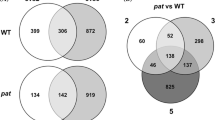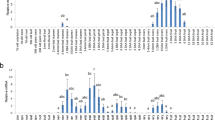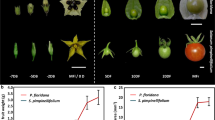Abstract.
Parthenocarpic mutants, which are able to set fruits in the absence of pollination and fertilization, offer suitable experimental systems to identify genes involved in fruit set and early ovary development. In this study, RNA populations extracted from ovaries of a parthenocarpic fruit (pat) tomato line and from the corresponding near isogenic wild-type were compared by differential display. cDNA was obtained from ovaries collected 1–2 days before anthesis, the stage when the expression of parthenocarpy is first visible. We describe here the sequencing and characterization of three genes that were differentially displayed in pat mutant ovaries compared to the wild-type. The protein predicted by the full-length cDNA reconstructed from clone 66 showed homology to peptides encoded by self-incompatibility alleles of Papaver rhoeas and had a strictly ovary-specific expression. The up-regulation seen at fruit set was an event specific to the expression of parthenocarpy, because it was also found in ovaries of a parthenocarpic fruit-2 line, a mutation which is not allelic to pat. The putative polypeptide deduced from the cDNA reconstructed from clone 72 showed high homology to plant H2A histones. Several EST sequences of this gene have been sequenced from expression libraries of tomato flowers, ovaries and leaves, although it seems to be preferentially transcribed in ovaries. A third fragment (clone 91) was identical to the 3′ region of GAD3, a tomato mRNA sharing similarities to short-chain alcohol dehydrogenases. RT-PCR-based expression analysis revealed that this gene is preferentially transcribed in ovaries, sepals and leaves. The tenet that this enzyme family has important functions in developmental pathways controlled by hormones, and in particular gibberellins, is supported by its increased transcription at the time of fruit set, by its positive response to treatments with gibberellin A3, and by its expression in the mitotic cell layers of the placenta.
Similar content being viewed by others
Author information
Authors and Affiliations
Additional information
Electronic Publication
Rights and permissions
About this article
Cite this article
Testa, G., Caccia, R., Tilesi, F. et al. Sequencing and characterization of tomato genes putatively involved in fruit set and early development. Sex Plant Reprod 14, 269–277 (2002). https://doi.org/10.1007/s00497-001-0122-4
Received:
Accepted:
Issue Date:
DOI: https://doi.org/10.1007/s00497-001-0122-4




